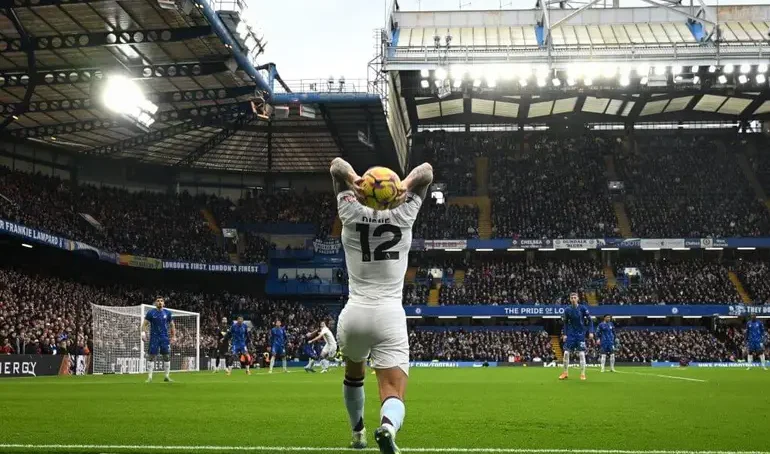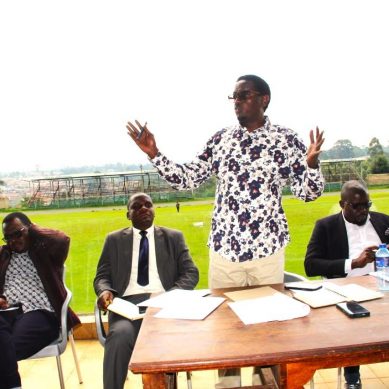
In many ways, the football we watch has become increasingly cultured in the Premier League, but ask yourself this: who doesn’t reminisce about Rory Delap’s iconic long throw-ins for Stoke City in the late 2000s?
The drop in directness from these towards the end of the previous decade in the Premier League coincided with a decrease in the percentage of goalkeeper passes played long – defined as ones that travel at least 32 metres (35 yards) – as more teams were focusing on maintaining possession, building out from the back, and recycling the ball if they lost it.
The trend of goalkeepers in England’s top flight playing fewer long balls has continued in the past couple of seasons. However, the usage of long throw-ins has experienced a U-turn.
Since 2021-22, Premier League teams have been hurling more throws into the opposition box when given the opportunity. In the Champions League this week, it was one of Arsenal’s main attacking threats against Paris Saint-Germain in the second leg of their semi-final.
Looking at the number of long attacking throw-ins – denoted as ones into the penalty area starting in the attacking quarter of the pitch – as a share of all throws in that zone, there has been a year-on-year increase, reaching 17 per cent this season.
The positive value of playing long throw-ins into the penalty area has been previously explored by The Athletic, but it’s not the only aspect of the ploy that needs to be accounted for.
The composition of a club’s squad, their aerial ability and suitability to defend on the transition – in case the arriving ball is lost to the opposition – are crucial factors that determine a team’s tactical decisions. Most importantly, you need to have a player who can launch throws into the penalty area from that zone.
Brentford and Nottingham Forest have been the flagbearers of this approach since their promotions to the Premier League in 2021-22 and 2022-23 respectively, with 54 and 40 per cent of their throw-ins in the attacking quarter of the pitch sent long.
This season, Brentford have heaved 92 throw-ins directly into the penalty area from the attacking quarter of the pitch. As a share of their total throw-ins from that location, their rate of 63 per cent is comfortably the highest in the Premier League.
Mapping Brentford’s throw-in approach on the pitch allows us to scrutinise things further.
Split across each side of the pitch, each throw is understandably targeted towards the near post, with a notably higher share arriving towards the goalmouth when taken from their right touchline – most often from Kevin Schade or Ethan Pinnock.
It is worth noting that the success of the long throw-in approach is not limited to getting first contact on the ball, but also profiting from the wider chaos that ensues from such an event.
Broadening Brentford’s expected goals figure (xG) across a wider 10-second window following the throw-in reveals just how strong they are from them. An xG of 3.9 via attacking throw-ins is comfortably the highest chance creation number in the league – more than double that of Crystal Palace (1.1), their nearest competitors for this metric.
Compare those figures to Forest, whose 52 long box-throws are the second-highest volume in the Premier League, and it only serves to highlight how efficient Brentford have been from this phase of play.
Forest’s 0.7 xG from long-throw sequences does not quite hit the heights in the way that is intended. Breaking it down per opportunity, Nuno Espirito Santo’s side manage just 0.01 xG per long throw-in – only good enough for 10th-best in the division.
For Brentford, their 0.04 xG per long throw-in is top of the list among all Premier League teams. The differences might not sound huge, but when margins are wafer-thin, the clinical edges can count for a lot. Similar to their corners and free kicks, Brentford have been using a certain setup to maximise their probability of scoring from long throw-ins.
Usually, their centre-backs position themselves towards the near post, with Christian Norgaard around the penalty spot and Yoane Wissa, Bryan Mbeumo and Mikkel Damsgaard lining up behind him to pounce on any second ball.
- The Athletic report








